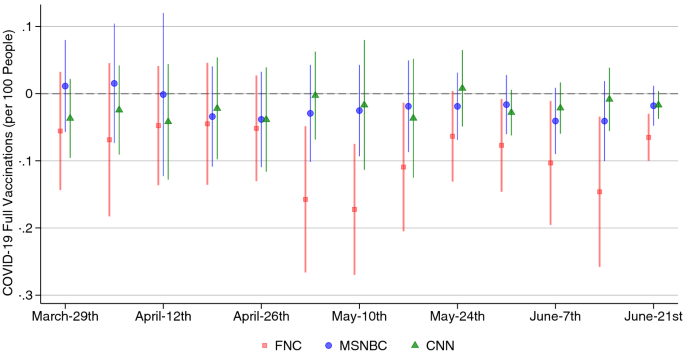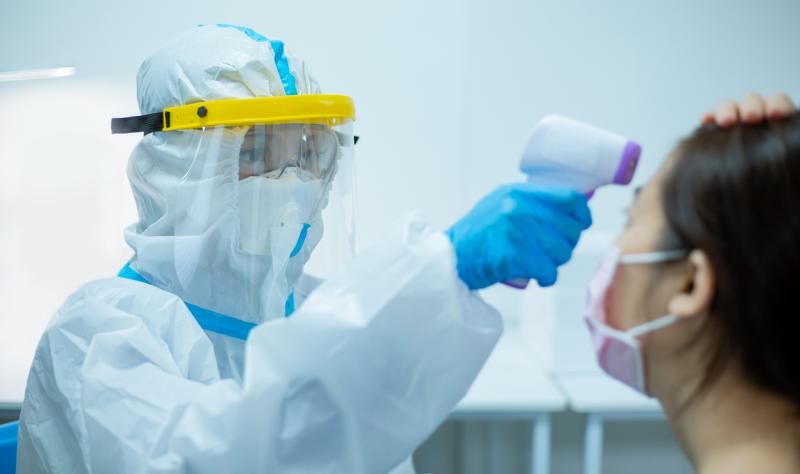Cable news and COVID-19 vaccine uptake | Scientific Reports

Since their introduction in late 2020, COVID-19 vaccines have bolstered the fight against the disease, substantially reducing the likelihood of infection and especially severe cases1,2,3,4. Given their proven effectiveness and the continued social costs of infection, the persistent resistance toward vaccination poses an urgent policy problem. Correspondingly, understanding the determinants of decisions to comply with or resist vaccines poses an urgent scientific question.
There is a small and timely literature providing some initial findings on this question. Exposure to online misinformation is associated with a decline in the willingness to take a COVID-19 vaccine5,6. Individuals who are opposed to the vaccine are less likely to obtain information about the pandemic from traditional and authoritative sources7.
We add to this research by exploring the role of cable news – a major class of U.S. television stations – in vaccine decisions. In the context of the COVID-19 pandemic, previous work has shown that conservative media consumption is associated with less social distancing8,9,10 and worse COVID-19 health outcomes11. These papers on COVID-19 are part of a broader literature on the effects of media on individual preferences and behavior12, political elections13,14,15,16, and local fiscal policies17. Because cable news providers vary in their skepticism toward COVID-19 vaccination, differential exposure to their programs might influence reported vaccine hesitancy and observed vaccine uptake. For example, Fox News Channel has been doubtful of scientific consensus and majority expert views18,19,20. In particular, Fox News Channel’s prime time show Tucker Carlson, one of the most popular prime time shows on FNC21,22, has taken a strong stance against vaccines, representing deaths following a vaccination to be caused by it, contradictory to available evidence21,22.
Our empirical approach pairs data on county-level vaccination rates with data on viewership of the main cable news providers: Fox News Channel (FNC), MSNBC, and CNN. We highlight that these are administrative, rather than survey data, so they are not biased by selective reporting.
In the early months of the vaccination campaign, we do not observe a relationship between cable channel viewership and vaccine uptake. However, in the more recent months starting in May 2021, Fox News viewership becomes negatively related to vaccine uptake. The relationships for the other cable news networks, MSNBC and CNN, remain unchanged.
We can show that the relationship between FNC viewership and lower vaccination uptake is causal using a natural experiment. The networks’ channel position in the lineup provides an exogenous instrument for viewership, as widely used in economics and political science10,13,16,17,23. Leveraging the exogenous variation in viewership, we estimate a local average treatment effect and find qualitatively coherent results. Exogenously higher FNC viewership due to channel position causes lower vaccine uptake.
The rest of the paper provides a number of supporting results to understand the most relevant mechanisms. Overall, the results support the interpretation that FNC promulgated a uniquely skeptical narrative about vaccines, that is, a narrative that downplayed their utility and promoted uncertainty on their safety, against the available scientific consensus. That narrative caught on and reduced uptake among the marginal vaccine recipient.
First, we look at the effect of cable news viewership on responses to a national survey, which asked respondents about their hesitancy to take the vaccine. In areas with higher FNC viewership, higher hesitancy to vaccinate was reported. Thus we can provide support for a behavioral mechanism, where FNC’s skeptical vaccine narrative affects vaccination rates by changing attitudes and intentions regarding the vaccine.
Second, we consider whether local health care capacity is driving our results. If that was the case, we should see an effect of Fox News on vaccine uptake also in the early as well as later stages of the vaccination campaign. Yet, we find no effect at all in the early stages while only individuals younger than 65 years old are affected in the later stages. Furthermore, we verify that FNC has no effect on local health care capacity metrics (number of ICU beds/hospitals) or stress metrics (number of COVID-19 infections/deaths).
Having ruled out health care capacity as a potential confounder, we further can infer from the above that the effect of Fox News on vaccine uptake is focused on relatively low-risk individuals (< 65 years) who potentially benefit less from vaccines than older individuals.
Third, we look at partisan affiliation or political ideology as vehicles for differences in beliefs and attitudes about vaccines. It could be that Republicans or conservatives are overall more skeptical of the COVID-19 vaccine, and that the effect of FNC works by increasing the number of Republicans or number of conservatives. Our results show that this is unlikely to be the case, as the effect of FNC on vaccine uptake holds even when controlling for partisan affiliation and political ideology.
Finally, we consider whether FNC has affected general attitudes towards vaccines, for example through anti-science rhetoric. To check this, we look at the effects on seasonal flu vaccines. There is no effect, suggesting that there is no generic anti-vaccine effect and that the effect on COVID-19 vaccines is due to a COVID-specific narrative.
Throughout the paper we address some of the caveats to our analysis: The compliers, i.e., casual television surfers that our instrumental variable analysis is based on, may be different from the general population. In addition, our study is limited to the early phase of the U.S. vaccination campaign during which (1) vaccinations began to be available widely and (2) vaccination certificates played no major role (e.g., to dine inside).
The findings in this paper provide timely insights on the COVID-19 vaccine deployment in the United States. The main cable news television providers are affecting vaccination decisions. Future efforts by government agencies and health organizations to encourage vaccine uptake should account for how media narratives may strengthen or weaken those efforts.
Cable news viewership and weekly vaccination rates, 2021. Coefficient plots with 95% CIs from OLS regressions looking at the association between one standard deviation changes in viewership on weekly vaccinations per 100 people. Regressions include demographic and cable-system controls. Standard errors are clustered by state.



